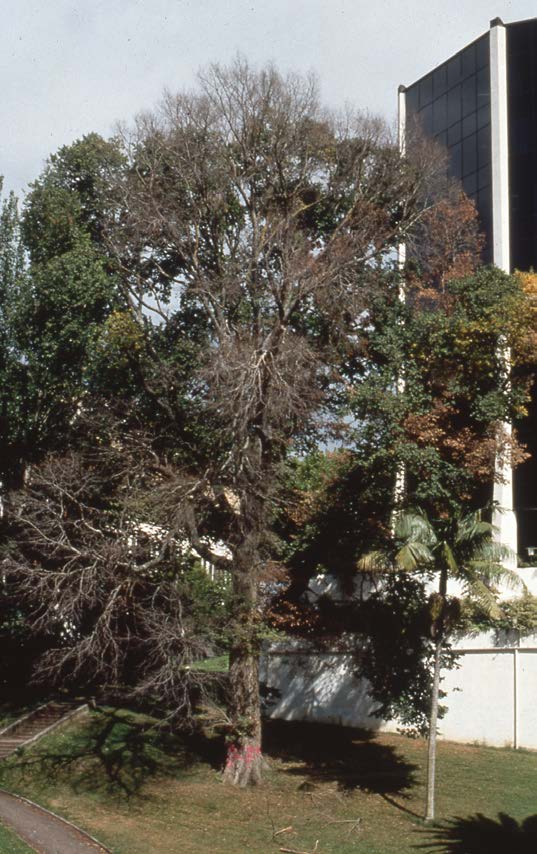PESTS AND DISEASES OF FORESTRY IN NEW ZEALAND
Dutch Elm Disease
Scion is the leading provider of forest-related knowledge in New Zealand
Formerly known as the Forest Research Institute, Scion has been a leader in research relating to forest health for over 50 years. The Rotorua-based Crown Research Institute continues to provide science that will protect all forests from damage caused by insect pests, pathogens and weeds. The information presented below arises from these research activities.
From Forest Health News No. 229, October 2012.
Dutch elm disease, caused by Ophiostoma novo-ulmi, was first found in Myers Park, Auckland in December 1989. Scolytus multistriatus, a European bark beetle and one of the known vectors of the fungus, was detected at the same time. Surveys indicated that the disease was limited to only a part of greater Auckland and an eradication programme was started.

The programme followed a strategy of locating all elms in the infected area, inspecting all known elms at least three times during the flight season of the vector beetle and felling, fumigating and burying all infected material immediately after detection. Trapping of S. multistriatus adults using an aggregating pheromone and plating of all trapped beetles on to a selective medium for O. novo-ulmi to detect contaminated beetles also formed a part of the strategy after the first season. After twenty-three years eradication has not been achieved, although the disease is still contained within the Auckland area.
The Ministry of Agriculture & Forestry stopped providing financial support for the programme after the 2006-07 season, and funding is now provided by Auckland Council with in-kind contributions received from Treescape Ltd, Scion and SPS Biosecurity. Treescape completed six removals at no cost to the programme, one included trees in Pakuranga that required significant traffic management.
The 2011-12 programme consisted of one continuous disease detection survey over the summer and a pheromone trapping programme (67 traps) in high risk areas to determine sources of infection or large amounts of breeding material. The disease detection survey started in December 2011 and was completed in May 2012. All elms recorded in areas considered to be a high risk were surveyed. The traps were inspected weekly from early December 2011 until late April 2012.
A total of 58 elm samples were received during the season (the previous season was 66) and 31 trees from 23 locations were infected with O. novo-ulmi. This was a significant increase from the previous season when only four infected trees at four locations were found. Only two diseased elms were discovered before Christmas.
During the season 2,200 beetles were trapped. This compares with 10,259 in the 2010-11 season. Only 0.55% of the beetles were positive for O. novo-ulmi compared to 1.54% the previous season. Interestingly just three traps accounted for 53% of all the beetles caught. One was in Pakuranga, one on Henderson Valley Road and the third Whitford. The Pakuranga and Henderson Valley traps had the highest catches in 2010-11. The Whitford trap was not there in the previous season.
In April 2012, a large group of dead and dying elms was found in a gully off Clifton Road, Whitford. Healthy elms were also in the gully. Some of the standing dead elms were at least two seasons old. Because of access difficulties the elms were not sampled until September 2012. On 24 September O. novo-ulmi was isolated from those samples. The dying trees have been removed and the site treated.
For further details see: http://www.nzherald.co.nz/nz/news/article.cfm?c_id=1&objectid=10837606
John Bain and Lindsay Bulman
This information is intended for general interest only. It is not intended to be a substitute for specific specialist advice on any matter and should not be relied on for that purpose. Scion will not be liable for any direct, indirect, incidental, special, consequential or exemplary damages, loss of profits, or any other intangible losses that result from using the information provided on this site.
(Scion is the trading name of the New Zealand Forest Research Institute Limited.)

 Farm Forestry New Zealand
Farm Forestry New Zealand

